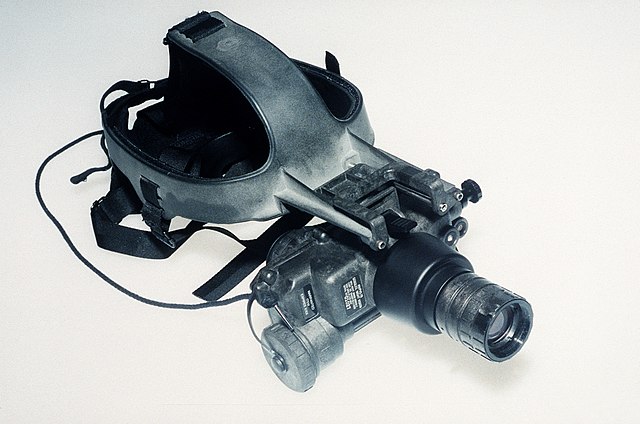Nanocrystals May Enable Low-Power Night Vision Glasses
Researchers from Australian National University (ANU) have incorporated nanocrystals to turn normal eye glasses into light-weight night-vision ones.
Researchers from Australian National University are using nanocrystals to bring radical innovation to night-vision technology. The promising technology looks to minimize the need for heavy battery power and opens doors for new applications of night-vision technology to other domains.
These crystals, which are 500 times smaller than a human hair, can change the intensity and color of light. Researchers have designed the crystals in a way that turns infrared into visible light. The main idea is to create a night-vision device by covering normal lenses with an ultra-thin film of these tiny structures. As a result, the new night-vision glasses have the potential to be much lighter than the conventional bulky binocular-like devices and may replace them in near future.
Current Night-Vision Goggles (NVGs)
Conventional night-vision goggles use an objective lens along with a photocathode to sense the low-level, near-infrared light and convert the photons into electrons. Then, an electron multiplier amplifies this electronic signal and releases hundreds of electrons. Finally, these electrons, which have the same pattern as the target photons, are guided to illuminate a phosphorescent material, effectively enabling vision at night.
Current high-performance night-vision goggles, such as L-3 Ground Panoramic Night Vision Goggles, cost about $65,000. These expensive NVGs offer acceptable resolution and contrast; however, they are still cumbersome. The current form factor is not at all suitable for the target applications, which are mainly military operations.
Over the years, there has been little advancement in reducing the weight and size of these devices while increasing the field of view.
Prototype of third-generation night-vision goggles. Image courtesy of the US Department of Defense.
ANU’s Night-Vision Goggles
On the other hand, the ANU invention dramatically simplifies the process by utilizing aluminum gallium arsenide nano-antennas which are capable of directly modifying the intensity and color of light. Acting as laser guides, the crystals receive a photon emitted in the infrared, combine them with photons from a laser, and finally upconvert the combined photons to the visible spectrum.
In this case, photons from infrared are directly converted to visible light and there is no need to first produce an electronic signal and then process it. The invention still requires battery power for the laser that amplifies the image. However, the final prototype will probably use a small integrated laser similar to those used in DVD players, and these lasers can be powered by a small battery. Since the nanocrystals are so small that four or five million of them could be placed on a one-square-millimeter substrate, the form factor would be reduced to a very thin film.
According to Maria del Rocio Camacho-Morales, a PhD student involved in the project, one of the main challenges of the invention was to grow a nano semiconductor on a transparent material. This is particularly important for optical displays where a transparent material is required to let light through. The Australian group is the first in the world to achieve this feat.
As co-researcher Dr. Mohsen Rahmani notes, the study is a significant step forward in understanding how the light interacts with objects at the nano-scale.
The Challenges Ahead
So far, the research team has successfully converted a single-frequency, high-intensity infrared laser light into visible light. Unfortunately, the intensity of light plays a major role in the operation of the designed nano structures. In real-world situations, the infrared light would be of lower intensity and the new NVG may, therefore, fail. Hence, there is probably a long way to go before we could see this technology used on the market.
Another challenge ahead is related to the multi-frequency nature of the real situations. For a multi-frequency light, researchers need to incorporate crystals with different sizes where each crystal is responsible for converting a particular frequency. To capture all of the frequencies in the invisible light, researchers will need millions of nano structures with different dimensions. They expect that, using the new NVG, the warmer spectrum would seem bluish and the cooler would look reddish.
Other Potential Applications
The nano crystals, which can engineer complex light beams, hold the potential for many other civilian possibilities. Employing these crystals with a laser, we could create a system to project a holographic image in modern displays. Moreover, the invention, which is the result of a 15-year research project, has the potential to be used in anti-counterfeiting measures for bank notes and imaging cells for medical applications.
As Dr. Rahmani notes it is possible to grow the nanocrystals on any glass surface including a car windscreen. In this way, the nighttime driving safety could be considerably improved.
According to Professor Dragomir Neshev from ANU Research School of Physics and Engineering's Nonlinear Physics Centre, the hard bit of the new NVGs was the design and although the fabrication is challenging, it is somehow similar to the fabrication of high-performance solar cells for space deployment.
The research team has submitted a proposal to DARPA to further advance the technology. According to defenceone.com, in 2014, DARPA posted a call for “compact, lightweight, heads-up, broad-band night vision display system for ground soldiers featuring cross-band infrared sensing and illumination for robust all-condition viewing.”
The details of this research are published in Nano Letters.








